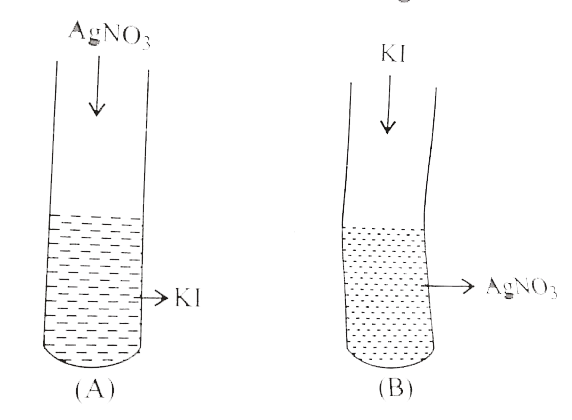Complete Solutions to HIGHER ORDER THINKING SKILLS of chapter SURFACE CHEMISTRY of Class 12 book with complete answers and questions
| Class 12 | CHEMISTRY |
| Chapter | SURFACE CHEMISTRY |
| MODERN PUBLICATION | HIGHER ORDER THINKING SKILLS |
| Number Of Questions | 10 |
| Academic Year | 2023-24 |
`SnO_(2)` forms positively charged colloidal sol in acidic medium and negatively charged colloidal sol in basic medium. Explain ?
View SolutionWhy is chemical adsorption unimolecular while physical adsorption is multimolecular?
View SolutionAdsorption of a gas on the surface of solid is sgenerally accompanied by decrease in entropy but still it is spontaneous in naturre. Explain.
View SolutionWhy are medicines more effective in collidal state ?
View SolutionAssertion: The passage of `H_(2)S` through aqueous solution of `SO_(2)` gives yellow turbidty of `S` in solution. Reason: The yellow turbidity of `S` is in colloidal state due to oxidation of `H_(2)S` by `SO_(2)(aq)`.
View SolutionA colloidal solution of `Agl` is prepared by two different methods as shown in the figure below:


What is the charge of `Agl` colloidal particles in the two test tubes `(A)` and `(B)` ?
b. Given reasons for the origin of charge.
View SolutionWhy the sun looks red at the time of setting ?
View SolutionIn an adsorption experiment, a graph between log `(x/m)` versus log `P` was found to be linear with a slope of `45^(@)` . The intercept on the log `(x/m)` axis was found to be `0.3010` . Calculate the amount of the gas adsorbed per gram of charcoal under a pressure of `0.5` atm` .
View Solution50 mL of 1M oxalic acid is shaken with 0.5 g of wood charcoal. The final concentration of the solution after adsorption is 0.6 M. Calculate the amount of oxalic acid adsorbed per gram of charcoal.
View SolutionOne gram of a water insoluble substance of density `0.8 g cm^(-3)` is dispersed in 1 L of water forming a colloidal solution having `10^13` particles of spherical shape per `mm^3`. Calculate the radius of the particle.
View Solution
HIGHER ORDER THINKING SKILLS questions and complete solutions for chapter SURFACE CHEMISTRY of MODERN PUBLISHERS CHEMISTRY (HINGLISH) of Class 12
All Exercises from MODERN PUBLICATION Class 12 CHEMISTRY SURFACE CHEMISTRY
- COMPETITION FILE (OBJECTIVE TYPE QUESTIONS) (A. MULTIPLE CHOICE QUESTIONS WITH ONLY ONE CORRECT ANSWER)
- COMPETITION FILE (OBJECTIVE TYPE QUESTIONS) (B. MULTIPLE CHOCE QUESTIONS FROM COMPETITIVE EXAMINATIONS)
- COMPETITION FILE (OBJECTIVE TYPE QUESTIONS) (C. MULTIPLE CHOICE QUESTIONS WITH MORE THANONE CORRECT ANSWERS)
- COMPETITION FILE (OBJECTIVE TYPE QUESTIONS) (D. MULTIPLE CHOICE QUESTIONS BASED ON THE GIVEN PASSAGE/COMPREHENSION)
- COMPETITION FILE (OBJECTIVE TYPE QUESTIONS) (MATCHING LIST TYPE QUESTIONS)
- COMPETITION FILE (OBJECTIVE TYPE QUESTIONS) (MATRIX MATCH TYPE QUESTIONS)
- CONCEPTUAL QUESTION 1
- CONCEPTUAL QUESTION 2
- HIGHER ORDER THINKING SKILLS
- NCERT FILE (SOLVED) (NCERT IN-TEXT QUESTIONS)
- NCERT FILE (SOLVED) (NCERT TEXTBOOK EXERCISES )
- NCERT FILE (SOLVED) (NCERT EXEMPLAR PROBLEMS )(MULTIPLE CHOICE QUESTION (TYPE-I))
- NCERT FILE (SOLVED) (NCERT EXEMPLAR PROBLEMS) (ASSERTION AND REASON TYPE QUESTIONS)
- NCERT FILE (SOLVED) (NCERT EXEMPLAR PROBLEMS) (MATCHING TYPE QUESTIONS )
- NCERT FILE (SOLVED) (NCERT EXEMPLAR PROBLEMS) (MULTIPLE COICE QUESTIONS (TYPE-II))
- NCERT FILE (SOLVED) (NCERT EXEMPLAR PROBLEMS) (SHORT ANSWER TYPE QUESTIONS)
- QUICK MEMORY TEST (A. SAY TRUE OR FALSE)
- QUICK MEMORY TEST (B. COMPLETE THE MISSING LINKS)
- QUICK MEMORY TEST (C. CHOOSE THE CORRECT ALTERNATIVE)
- REVISION EXERCISE (ASSERTION REASON QUESTIONS )
- REVISION EXERCISE (LONG ANSWER QUESTIONS )
- REVISION EXERCISE (OBJECTIVE QUESTIONS) (MULTIPLE CHOICE QUESTIONS)
- REVISION EXERCISE (PASSAGE BASED QUESTIONS)
- REVISION EXERCISE (SHORT ANSWER QUESTION)
- REVISION EXERCISE (VERY SHORT ANSWER QUESTIONS )
- SOLVED EXAMPLES